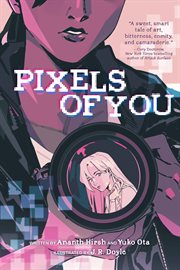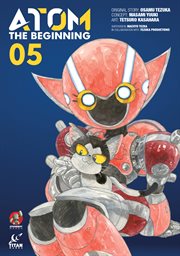Review by Publisher's Weekly Review
Via a semifuturistic New York City populated by people and sentient artificial intelligences, Hirsh and Ota (Lucky Penny) present the moody chronicling of a relationship just beginning. Indian American artist Indira interns at a gallery while acclimating to a robotic eye; when Fawn, an AI in a human-looking "natural chassis" portrayed with pale skin and hair, is hired as a new intern, the photographers' dislike is immediate. Fawn thinks Indira's images of AIs are objectifying, and Indira finds Fawn's plant photographs "too safe." After an outburst in the gallery, its owner makes their year-end exhibition a collaboration. As the two work grudgingly together, each begins to understand the other's perspective, and their rivalry slowly grows into a tender new closeness. Doyle's angular art makes smart use of color, for example rendering Fawn's form pale against a saturated palette as the characters' interactions touch on issues of othering, including immigration, class, race, and sentience. In this quietly paced character study with a cinematic feel, a melancholy atmosphere slowly blooms into something warm and hopeful amid news headlines documenting concerns about implicit bias in AI. Ages 12--up. (Feb.)■
(c) Copyright PWxyz, LLC. All rights reserved
Review by School Library Journal Review
Gr 7 Up--A moody, meditative vignette of a relationship taking root. Indira and Fawn are both aspiring artists on the grind at a hip urban art gallery. They're also rivals, in part because Fawn is a humanoid robot, and Indira feels haunted by the rise of artificial intelligence. One of Indira's eyes is robotic, replaced after a tragic accident that killed her parents. Her automated eye, coupled with the circumstances of her loss, causes her ongoing distress--and she's suspicious of Fawn. Fawn has problems, too; she faces insidious anti-robot discrimination and sometimes struggles to connect with her parents, who are robots but don't present as humans as she does. As Fawn and Indira are forced to work together, their assumptions about each other begin to break down, and they start to care about each other and learn from their differences. But the book isn't as didactic as it may sound--the robot/human relationship serves as a reflection on managing cultural alienation, and the girls' chemistry is well developed, building to a surprising, sweet conclusion. Hirsh and Ota's story is a combination of broad narrative strokes and intimate moments, and Doyle's manga-inspired, deliciously purple and pink illustrations float with ease through a near-future New York. Indira is South Asian American, and Fawn inhabits a white body. VERDICT Though aimed at young adults, this one will resonate with some adult readers, too. Light but thoughtful sci-fi for fans and skeptics alike.--Emilia Packard, Tokyo
(c) Copyright Library Journals LLC, a wholly owned subsidiary of Media Source, Inc. No redistribution permitted.
Review by Kirkus Book Review
Biased AI, creativity, and the line between human and machine collide--and sparks fly. In a near-future New York City, at a time when artificial intelligence has become ubiquitous, powering self-driving cars and more, Indira and Fawn are unpaid interns perfecting their photography skills. But there's one major difference between the two: Fawn is AI, while Indira is human. Indira is taciturn with Fawn until their boss, noticing the animosity between them, declares that they must work together to create a joint photography exhibition. Forced to spend time together, Fawn and Indira begin to learn more about each other and the ways in which both human and AI society don't always allow them to fit in--Indira because she is Indian American and Fawn because of her outward appearance as a young White woman. Drawn in a manga style, the story follows Indira and Fawn as they explore the city, alternating between light banter and discussing heavier topics. Ultimately a short but sweet story about two girls slowly falling in love, there are enough details here to raise interesting questions about human-made algorithms and bias coded into artificial intelligence but not enough to fully flesh out the world. The art, however, is striking, with bold, stark colors; plays on light and dark; and disrupted frames depicting photos and extending emotional moments. The feelings of a Sapphic short story plus questions about the darker aspects of technology. (Graphic science fiction. 13-18) Copyright (c) Kirkus Reviews, used with permission.
Copyright (c) Kirkus Reviews, used with permission.




